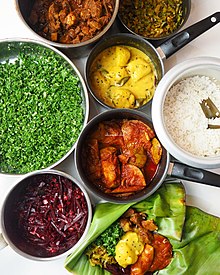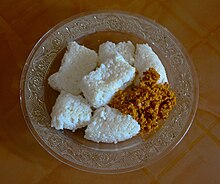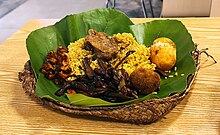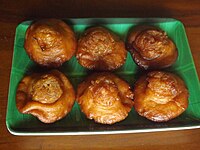Sri Lankan cuisine
This article includes a list of general references, but it lacks sufficient corresponding inline citations. (March 2020) |

Sri Lankan cuisine is known for its particular combinations of herbs, spices, fish, vegetables,
Sri Lanka is historically famous for its cinnamon. The 'true cinnamon' tree, or
Regions
In areas located on the island's coasts seafood is a standard feature of the local dishes.
Common ingredients
Spices:
Herbs:
Fish:
Grains:
Oils: coconut oil, sesame oil, cow ghee, buffalo ghee, mustard oil
Sweetners: kithul
Vegetables and greens:
Meats:
Yams, roots and tubers:
Other: Coconut milk and grated coconut are ubiquitous in the cuisine, and are freshly prepared almost every day in most households. Maldives fish is heavily used in vegetable dishes to add an umami flavour.
Fruits:
Dishes
Rice and curry


The central feature of Sri Lankan cuisine is boiled or steamed rice, served with a
Dishes are accompanied by pickled fruits or vegetables,
Kiribath
Kiribath or paal soru (lit. 'milk rice') is rice cooked in salted coconut milk until the grains turn soft and porridge-like. Generally eaten for breakfast, kiribath is also prepared on special occasions such as birthdays, New Years' and religious festivals. It is usually served with lunu miris, a relish made with red onions and chillies. There is also a method of cooking kiribath with
Kottu
Kottu is a spicy stir-fry of shredded roti bread with vegetables. Optional ingredients include eggs, meat, or cheese. It was invented in Batticaloa and literally means 'chopped roti' in Tamil.
Hoppers

Hoppers (appa in Sinhala) are based on a
String hoppers
String hoppers (idiyappa in Sinhala) are made from a hot-water dough of rice meal or wheat flour. The dough is pressed out in circlets from a string mold onto small wicker mats, and then steamed. This dish is typically not eaten plain and is often paired with a curry, such as Kiri hodi.
Lamprais

A
Kool
Kool is a seafood broth from
root flour.Pittu
Pittu[5] are cylinders of steamed or roasted rice flour mixed with grated coconut.[6]
Roti
Godamba roti is a simpler Sri Lankan flatbread usually made from wheat flour.
Most popular roti is Pol roti, where shredded coconut is mixed into the dough. Another variant is spicy roti, in which chopped onions and green chilies are used when making the dough.
Sambal
Sambals (Sambol in Sinhala) are enjoyed with many dishes including curry dishes and string hoppers.
Mallung
Mallung is a condiment or side dish, comprising chopped greens which are lightly cooked and mixed with grated coconut and red onions.
Malay Achcharu
Malay Achcharu also known as Sri Lankan Malay pickle or simply as Achcharu is a dish that originated from the local Malay community and is now widely popular among all ethnic groups in the country.[8][9] It is a selection of vegetables in a pickled sauce and blends sweet, sour and spicy flavours.[10]
Chinese chili paste
Chinese chili paste is a condiment eaten alongside Sri Lankan-style Chinese dishes.[11]
Babath
Babath or offal consists of the stomach of cattle or goats. It is cooked as a curry or deep fried and eaten with rice or more famously with Pittu. Its origins are associated with the Sri Lankan Malay community but it is very common among the Moor community as well. The preparation of babath also consists of Kodal or the in states of the animal.[12]
Sate

Sate is of Indonesian origin and has become a staple of the Sri Lankan diet.[13] They are served with peanut and chili sauce.[14]
Ekor sop
Ekor sop, oxtail soup, is a delicacy of the Sri Lankan Malay community.[15][16]
Nasi goreng and mee goreng
Nasi goreng (Sinhala: නාසි ගොරේන්) and mee goreng are popular street food dishes in the country, a result of cultural influences from Indonesia and the country's local Malay community.[17][18][19]
Sweets
A common dessert in Sri Lanka is flour is made into a paste and shaped like diamonds before frying. Other types of kevum include athiraha, konda kevum, athirasa, and handi kevum.
Many sweets are served with
Cakes and pastries:
- Aluwa - Diamond-shaped rice-flour pastries
- Bolo fiado - A Portuguese-style layer cake
- Bibikkan - A rich, cake-like sweet made from grated coconut, coconut treacle, and wheat flour. It is a specialty of coastal areas.
- Kokis - A savoury crispy biscuit-like dish made from rice flour and coconut milk.
- Pushnambu / Wandu Appa - A rich, cake-like sweet made from coconut treacle and wheat flour. Cinnamon/cardamom and sweet cumin is often added among the Christian population of Sri Lanka.
- Seenakku - a glutinous rice cake often served with grated coconut.[14]
Treacle-flavored sweets:
- Undu Walalu/Undu wal or Pani walalu - A sweet from the Mathale area, prepared using urad bean flour and kithultreacle.
- Aggala - Rice balls flavored with treacle
- Weli Thalapa - Made from rice flour and coconut treacle
- Aasmi - Made with rice flour and the juice of a leaf called dawul kurundu (okra juice can be used as a substitute), deep fried and topped with pink-coloured treacle.
Puddings and toffees:
- .
- eggs, and jaggery. First introduced by the Malayimmigrants, watalappam has become a staple of Sri Lankan desserts.
Other sweets:
- Thala Guli - Made from ground sesame and jaggery with finely grated coconut.
- Kiri aluwa or Milk Toffee - Made with sweetened condensed milk or sugar-thickened pure cow's milk. Cardamom/sweet cumin and cashews are added for more taste.
- Sri Lankan sweets
-
Konda Kevum
-
Kokis
-
Kalu Dodol
-
Sri Lankan Swiss roll
Short eats

"
Short eats include pastries, Chinese rolls and patties. Other short eats include:
- Vade - savoury deep-fried fritters made from various ingredients. Varieties include parippu vade (lentils), ulundu vade (black gram and rice), isso (shrimp) vade, crab vade
- Chinese rolls or egg rolls, which often contain minced meats, potatoes, and vegetables
- Patties and pastries - filled with vegetables, meat, or fish
- Vegetable/fish roti - a flatbread with a filling rolled into a triangular shape and baked
Short eats are served at parties or to guests when they visit a home. Western food such as hot dogs and hamburgers have arrived in Sri Lanka, with the globalization of fast-food chains such as McDonald's, KFC and Pizza Hut. However, foods from these establishments are not usually considered short eats. Additionally, hot dogs and hamburgers are also modified to fit local tastes.
Beverages
Beverages commonly served in Sri Lanka include:
- Faluda - a mixture of syrup, ice cream, jelly pieces and basilseeds, served cold
- passionfruitjuice
- King coconut water
- Tea
- palm tree sap
- Arrack - an alcoholic spirit made from the fermented sap of the coconut flower.
- Wood apple juice
See also
- Faluda
- Kottu
- Pittu
- Traditional rice of Sri Lanka
References
- ^ Reeves, Peter (2014). The Encyclopedia of the Sri Lankan Diaspora. Editions Didier Millet. p. 39.
- ISBN 9781743581728.
- ^ "Water Lilies: Beautiful and Resourceful".
- ^ "Easy recipe for Appa". Infolanka.com. Retrieved 21 March 2013.
- ^ "Mani Puttu recipe". Kish.in. 5 February 2010. Retrieved 21 March 2013.
- ^ "Recipe for Pittu". Infolanka.com. Retrieved 21 March 2013.
- ^ "Coconut sambol (pol sambol)". 23 July 2013.
- ^ "Sri Lankan Malay Pickle (Malay Achcharu) - Food Corner". 29 September 2011.
- ^ "Malay Pickle (Sri Lankan Style)". www.dailyfoodrecipes.com.
- ^ Kareem, Nasuha (21 September 2014). "Lavish Treats: Malay Pickle (Achcharu)".
- ^ Anthony Bourdain (25 October 2017). "Ni Hao, Colombo". Explore Parts Unknown. Retrieved 10 December 2017.
- ^ "Site Suspended". easternsrilanka.natgeotourism.com.
- ^ "Mabole Malay Association". Mabolemalay.com. Retrieved 19 September 2018.
- ^ ISBN 9781462907182– via Google Books.
- ^ "EKOR SOUP (Oxtail Soup) - Malays.lk". 15 August 2016.
- ^ "Resipi Makanan Melayu - Traditional Sri Lankan Malay Recipes - Curry - Chutney". Scribd.
- ^ "Nasi Goreng (Indonesian Fried Rice) - Food Corner". 30 April 2011.
- ^ ShaliniIR. "Nasi Goreng". YAMU.
- ^ "Mee Goreng - Unilever Food Solutions". Unilever Food Solutions.




